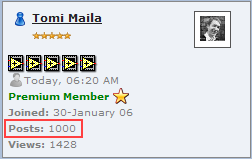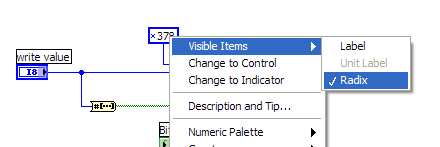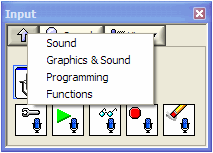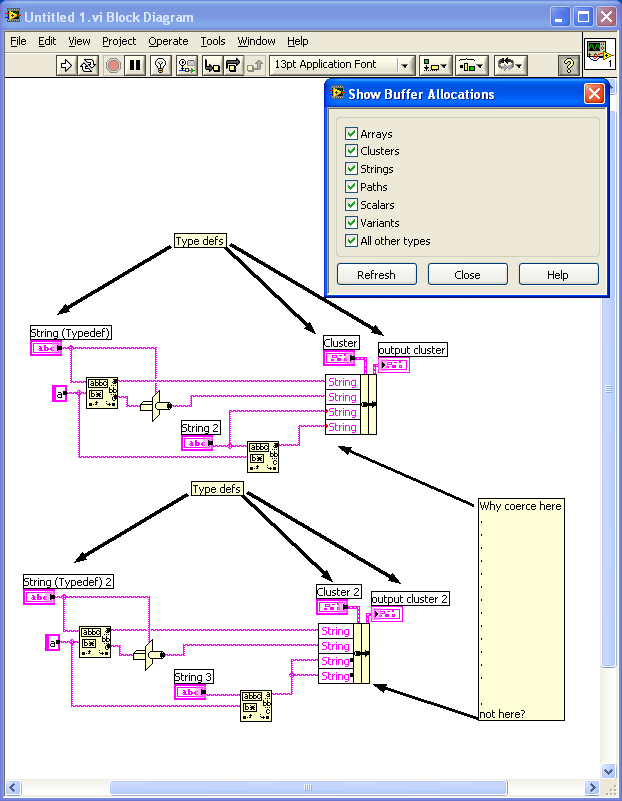
LAVA 1.0 Content
-
Posts
2,739 -
Joined
-
Last visited
-
Days Won
1
Content Type
Profiles
Forums
Downloads
Gallery
Posts posted by LAVA 1.0 Content
-
-
Hello,I was trying to read the Frame names of a case structure. I wrote a small code for doing that. But Labview is throwing up an error as attached below... I am not able to understand why this error is thrown? Please suggestQUOTE(guruthilak@yahoo.com @ Jan 8 2008, 05:15 AM)
Got it .. I made a silly mistake .. Should have used "Open VI Object Reference" instead of "New"Hello,I was trying to read the Frame names of a case structure. I wrote a small code for doing that. But Labview is throwing up an error as attached below... I am not able to understand why this error is thrown? Please suggest -
QUOTE(crelf @ Jan 7 2008, 08:12 AM)
You're right - it doesn't work with LabVIEW 8.x. If you want to do scripting, you need to contact NI to get a license for it. That said, you can still use the key in LabVIEW 7.x, then open the code in 8.x and it'll still be there.NI INDIA is of no help. They dont know anything about it

Any other way of doing it other than importing from LV 7.X
By the way Chris, do u remember me ?
-
Hi,
How to enable the property "BlockDiagram" to be made visible in Property nodes for Labview version 8.2 onwards.
The string "SuperPrivateScriptingFeatureVisible=True" in the ini file (which works with LabVIEW 7.X) does not seem to be working? Can anybody reply me with some answers
-
ZITAT(Jim Kring @ Jan 6 2008, 11:56 PM)
I tried disabling all my virus, firewall, and spyware protection software: PC-cillin, Windows Firewall, Windows Defender, and Spybot - Search & Destroy. Still LabVIEW 8.5 cannot open HTML help
Jim, are you able to open URLs in your default browser from within other applications e.g. chats, or your mail client?
Henrik
-
QUOTE(Yen @ Jan 5 2008, 01:11 PM)
If you don't mind platform dependence, you can call the reparenting functions in Windows to actually move the window into your front panel, but you should note that this comes with its own set of problems. Searching for MDI here and in the NI forums should show some examples.I just tried out Tons example and the VI running in his sub-panel seems to be able to "see" an AE just fine.
I have to look closer!
Ben
-
QUOTE(ragglefrock @ Jan 5 2008, 12:40 AM)
You could use your action engine to abstract away the fact that you're using tcp to transmit the data to the subvi.I was concidering the same thing while drink my coffee this AM but then reconcidered. Yes it would work but it would but a restrction on the code that runs in the sub-panel. THe code running in the sub-panel would have to use VI server calls that I could wrap in an AE. But that would mean the sub-panel code would have to be written to run in the sub-panel. I was hoping for an implementation that did not put restriction on the sub-panel code.
Ton,
If the Steelers weren't playing, I'd be "wasting" this Saturday night studying your code. Thank you very much!
Ben
-
QUOTE(tcplomp @ Jan 4 2008, 04:24 PM)
There goes one saturday night.I've http://forums.lavag.org/XControls-as-ChildWindows-t7205.html&p=27182' target="_blank">once written something like that (I assume).
Hopefully it can give you any pointers.
Ton
Man it was hard to find.
Thanks Ton! I'll look at it this wek-end.
BTW: I asked NI this Q before posting and they could not answer it. I told them, send me an e-mail and I'll send them a link to my Q on LAVA. At the same time I said "Ton probably knows."
Ben
-
Background Info:
I have been playing with code to support "Docking" and "Un-Docking" parts of my GUI's.
In this context the terms "Docking" and "Un-Docking" refer to being able to take take part of my screen (a tab page for examle) and opening it in a floating window that the user can re-size and position as they choose. The method I am using is nothing new. When "Docked" a FP is shown in a sub-panel. When it is "Un-Docked" I remove it from the sub-panel and show the FP.
The VI's that run in the sub-panels (have not been written yet, but ) will have to interact with the rest of my app using queues, AE's (LV2's) etc.
And since this will be re-used many times in various app's I was concidering developing an XControl to handle the work of Docking and Un-Docking.
BUT....there is some fine print for the XControl that says something about the XControl running in a different context and I can't talk to it using queues, etc.
Question:
Is it possible to develop an XControl to which I can pass a reference for a VI that can control the Docking of the VI?
If yes, please share.
Thank you,
Ben
-
-
QUOTE(Paul_at_Lowell @ Jan 3 2008, 03:04 PM)
If you are interested in OPM you may be interested in UML and SysML.... I do use UML to help with my object-oriented LabVIEW software designs and I do find it helpful....Hi Paul,
I started reading one of the recomended books on UML so I can better understand how to develop using the State Chart tool kit. Are you using the State Chart toolkit when you say you use UML?
Ben
-
I am going to be developing an app where the customers has provided diagrams using Object Process Methodology . A quick read of chapter one of a book on this topic has enticed me because it appears to be a formal method of diagraming systems. So.... I am interested in hearing from others about using OPM and how LabVIEW can fit into the picture. Ben PS: I'm going to cross-post this to NI.
-
-
FYI
Traditonal VI Re-cursion does now handle the branch version
A > B > A
No LVOOP required.
Ben
-
QUOTE(crelf @ Jan 2 2008, 02:35 AM)
http://lavag.org/old_files/monthly_01_2008/post-181-1199259246.png' target="_blank">

Congrats Tomi, and thanks so much for all your wpmderful posts so far. ;beer; here's to another 1k!
Congratulations Tomi !
Ben
-
I posted a list of things in this thread on the Dark-Side.
Ben
This list can also be found using the tag path
LabVIEW >>> LabVIEW_Performance >>> Optimize-Background-Services
-
QUOTE(cyrik @ Dec 24 2007, 02:51 PM)
I opened the VI to understand your answer and noticed one thing; the display format for the constant "378" was set to 'hex' on the block diagram, but the radix was NOT visible
 . So I guess the vi was technically correct, BUT the radix should be set to visible whenever using the 'non-default' display format for a numeric constant. Nice catch, and keep on posting!
. So I guess the vi was technically correct, BUT the radix should be set to visible whenever using the 'non-default' display format for a numeric constant. Nice catch, and keep on posting! -
QUOTE(Loganxyz3129 @ Dec 26 2007, 12:33 PM)
If you're more interested in the processing capabilities of LabVIEW, you should probably look at the sound and vibration or the signal processing toolkits.
LabVIEW has been used to build commercial grade audio applications; a company in Boston, MA USA called listeninc.com sells audio systems based on LabVIEW and various signal conditioning hardware.
-
While answering a Q on the Dark Side, Christian Altenbach could not definatively explain why coercion dots were shown or not shown in the sample code. So I asked an NI-App Eng to figure out what was happening.It took him somethime but he has replied and has said some note-worthy things.
- "hidden" coercion
- sub-string
- Coercion does not imply copy
...are some of the terms and ideas I think he has reported.
If inteested see this thread from the Dark Side.
Ben
- "hidden" coercion
-
Start a background VI with VI server that waits on a notifier. When the user clicks on the thumbnail, send the notifier to the background VI (presumably a filepath) and have that vi load the data into a queue. when the background VI is done, it just waits for another notifier.
In that same background vi, monitor the notifer while loading a file. If a new notifer arrives, close the current file, flush the queue and then begin loading the new file into the queue. Use a null path to tell the background vi to stop and wait for the next filename.
I can see where your user might get click happy and cause alot of file I/O. This might be a problem if using FLASH based storage or a slow network connection. You might want to add a small delay (1 second?) before opening the file and beginning to read.
Your background VI might use a notifier to tell the calling VI that the data is available. It could even be the same data type as that sent to the background VI (file name) When the calling VI gets a notifier that matches the sent message, it could flush the queue and render the image.
Just some quick ideas. Is this for your app on your home page?

-
I join with ohiofudu to wish Happy Holidays to LAVA community.

Thanks everybody to help LabVIEW users to look further in the software development.
-
QUOTE(i2dx2 @ Nov 11 2007, 09:57 PM)

-
QUOTE(Justin Goeres @ Dec 19 2007, 08:35 AM)
QUOTE(neB @ Dec 19 2007, 08:57 AM)
My hope is to build a web of realted terms such that novices can chase down related terms that do not show up in a normal serach.And for my part, I use these backwards when I can't remeber "SLIP" but I can remember IP_Over_Serial.And because the tags are all public, I can use the realationships defined by others.As I think about it more, tagging SLIP PPP etc. is probably fine. It allows the forum members to create an info-base that applies weight to certain data that might not show up high on a classic search.
As Justin said, applying tags to unsearchable items is great (pics, audio, or even LV source files?!) Maybe tagging posts containing block diagram images and VIs that can't be searched by keyword would be helpful. The first thing that comes to mind are some of Christian Altenbach's great examples like rotating an image. He provides code and screen shots that are good enough to be shipping examples/documentation (that's another story).
I will watch with interest how the tagging works out on the "other side". (I'm only a Proven Veteran and can't participate for now...
 )
) -
There are some nice Timestamp related functions in the MGI Freeware VIs.
You can use VI Package Manager to install them.
-
Its the end of the year and I've been thinking about my library tools (or lack there of). I wanted to brush up on palette and reuse skills, so I expanded on Norm's Error_OR vi.
I made it polymorphic to accept combinations of instances and/or arrays of error clusters/booleans. I also added a merge vi that can be dropped in the while loop to include the polymorphic VI and a compound arithmetic node.
Download File:post-949-1198081203.zip (LabVIEW 8.0)





HTML VI Documentation not working
in LabVIEW Bugs
Posted
ZITAT(Jim Kring @ Jan 7 2008, 06:40 PM)
Then you could try to find it out with the help of the Process Explorer from Sysinternals. Perhaps you will see some information why it doesn't be handed over to the default browser.
Henrik